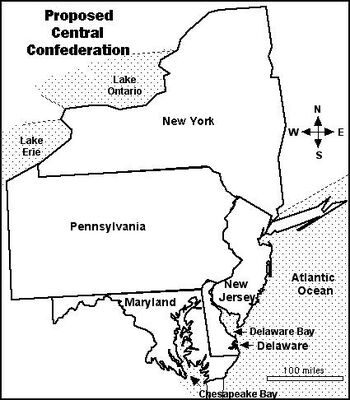
The Central Confederation, as proposed in the original draft of the Britannic Design.
The Central Confederation was an administrative unit of the Confederation of North America, proposed under the original version of the Britannic Design but not included in the final version. It is not entirely clear from Sobel exactly which colonies were to be members of it.
The armistice of 12 June 1778, ending the North American Rebellion, anticipated that the colonies would be granted self-government under something like the plans proposed by Joseph Galloway and John Dickinson before the outbreak of hostilities. But in the immediate aftermath of the war British North America was provisionally governed by generals acting as viceroys in specific districts: Sir Guy Carleton in Canada (what would become Quebec and Indiana), William Howe in the four New England colonies, John Burgoyne in "the middle colonies", and Henry Clinton in "Maryland and all colonies to the south". (Whether Delaware was under Burgoyne or Clinton is not clear.)
The original proposal for the Britannic Design also grouped the thirteen rebellious colonies into three "confederations", Northern Confederation, Central, and Southern, each with a royally appointed governor-general and a council consisting of one representative from each colonial legislature. But the distribution of colonies was different, as Sobel uses Maryland's membership in the Central Confederation as his example of how the system would work. Presumably the Southern Confederation had the four colonies Virginia and southward, and the Northern Confederation had New England, but the status of New York is not clear and not given in Sobel. Since New York City was increasingly viewed as the center of the entire Confederation, its colony may well have been considered to be "central".
In any event, as the proposed Design was debated in Parliament, members of the House of Lords expressed concern about the concentration of more rebellious areas in the Northern Confederation, and successfully proposed that the Northern and Central Confederations be merged. The new Northern Confederation thus by this reasoning consisted of nine colonies, including Maryland and Delaware. However, Sobel's map in the frontspiece of For Want of a Nail assigns both Maryland and Delaware to the Southern Confederation, and the text also mentions the Catholic minority in Maryland in a discussion of religious divisions in the Southern Confederation. The final status of these two provinces is thus not clear.
In For All Nails, both Maryland and Delaware are part of the Northern Confederation.
| Confederations of the C.N.A. |
|---|
| Central Confederation • Indiana • Manitoba • Northern Confederation • Northern Vandalia • Quebec • Southern Confederation • Southern Vandalia • Vandalia |
